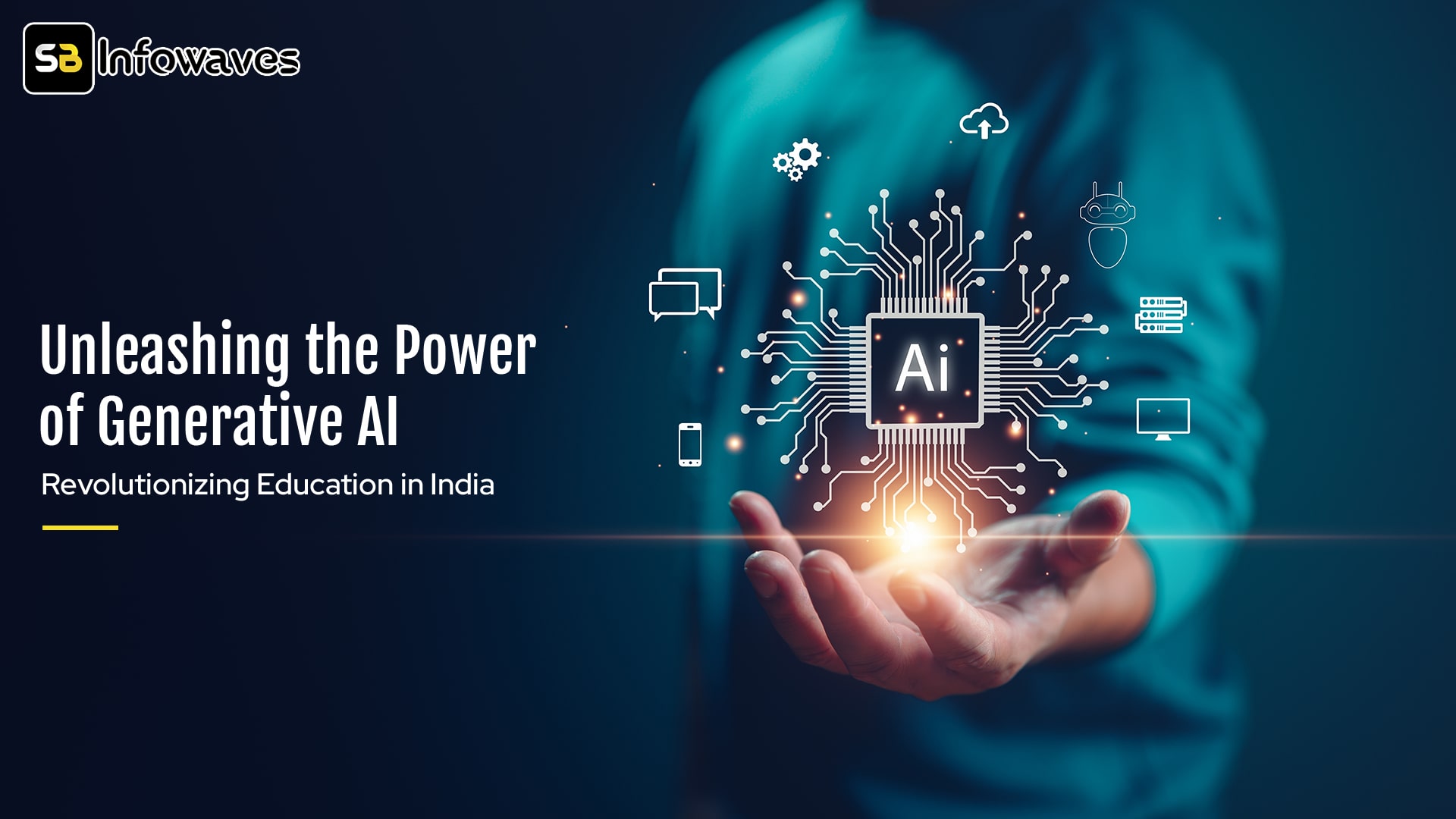
- Dec 05, 2023
Unleashing the Power of Generative AI: Revolutionizing Education in India
Artificial Intelligence (AI) refers to machines exhibiting certain facets of human intelligence, encompassing abilities like perception, learning, reasoning, problem-solving, language interaction, and creative output. In the last decade, AI has found its way into education, streamlining the management of students' performance data in schools. An illustration of this integration is evident in Uttar Pradesh, where the Nipun Assessment Test (NAT) employs AI to evaluate the skills of 1.6 crore students spanning grades 1 to 8. Additionally, AI facilitates seamless language translation and offers personalized learning tools to cater to individual student needs. Over the past year or thereabouts, generative AI, a specific category within the realm of artificial intelligence, has been gaining notable momentum. This subset employs deep learning techniques to analyze existing datasets and generate novel outputs. Distinguishing itself from its predecessors, generative AI boasts reasoning capabilities. Notable examples include ChatGPT, capable of generating human-like responses to textual prompts, and DALL-E, which excels in producing images and artworks based on textual inputs. The emergence of generative AI has sparked curiosity and captured attention. While it's still in its early stages, there's no definitive judgment yet. However, its potential has unlocked numerous possibilities. This article explores some of these prospects and emphasizes how generative AI can be efficiently integrated into the education sector.
Generative AI's Impact on Education
In a country like India, characterized by significant cultural and social diversity as well as inequality barriers, generative AI emerges as a valuable tool to bridge various gaps. Its potential benefits extend to different stakeholders within the education system, including students, teachers, and parents. Recognizing the importance of nurturing AI skills in children, CBSE has incorporated AI as a skill module in classes 6–8 and as a skill subject in classes 9–12. Furthermore, numerous organizations are actively developing virtual assistants tailored for students, teachers, and parents, enhancing their learning and teaching experiences. These initiatives are now manifesting across a wide array of use cases.Exploring Potential Applications of Generative AI:
- 1. Virtual assistants powered by generative AI offer parents innovative ways to enhance their child's reading and comprehension skills. For instance, parents can utilize AI-generated stories for narration or encourage their child to read aloud. This proves especially valuable for parents who may not be literate but still aim to actively participate in their child's educational journey.
- 2. Generative AI presents a time-saving solution for teachers adhering to prescribed teaching guidelines. Through a virtual assistant utilizing generative AI, teachers can efficiently plan unique and captivating classroom activities. By referencing carefully selected documents and expert insights, the assistant suggests effective methods tailored to a class setting, streamlining the planning process without extensive hours spent on multiple reading materials.
- 3. Tailoring to the unique needs of each child, this technology, when guided by a caring adult (be it a teacher, parent, or community member), proves highly beneficial in early childhood education. Its adaptability addresses the varying learning paces and approaches among children, making it instrumental in building foundational literacy and numeracy, as well as imparting basic language skills.
- 4. Generative AI excels in tasks such as speech-to-text, text-to-speech, and speech-to-speech translations. Moreover, it can dynamically adjust tone and cultural context during translation, fostering inclusivity in education for children hailing from diverse linguistic and sociocultural backgrounds.
- 5. Harnessing the potential of generative AI, virtual labs can be created on smartphones, particularly benefiting senior-grade and college students. This innovation is especially valuable for students from marginalized backgrounds who may lack access to physical labs for conducting science experiments or acquiring vocational skills. AI plays a pivotal role in helping them comprehend these skills and concepts.
- 6. Leveraging virtual assistants goes beyond resolving students' doubts; they play a pivotal role in nurturing essential skills like critical thinking, creativity, problem-solving, and communication. The effectiveness hinges on how one tailors the virtual assistant's training to aid students in honing these abilities. Students can engage with the virtual assistant using their local language, either through speech, written text, or direct typing. Additionally, school apps integrating virtual assistants offer customization options for students, teachers, and parents to monitor assignments, attendance, results, and more. Numerous organizations like SB Infowaves are already piloting these initiatives, collaborating closely with stakeholders on the ground to ensure their practicality and impact.
Strategies for Optimal Integration
While various approaches exist for implementing generative AI, its adoption in the education sector currently remains minimal and experimental. To enhance its effectiveness in our programs, the following considerations should be taken into account:- 1. Selecting Appropriate Challenges : Amidst the plethora of potential applications for generative AI, it is crucial to ensure that our focus is on tackling the right issues. For instance, identifying the actual challenges faced by teachers in classroom instruction and management is key. Are there more constructive methods available? How can teachers address these challenges without sacrificing their autonomy? Are the suggestions provided contextually relevant and feasible for teachers to implement? An effective approach involves gaining insights into the challenges faced by the target audience and relevant stakeholders. Utilizing forums, events, user research, and engaging focus group discussions, we delve into the community's real-world experiences. This process serves as a valuable guide for shaping both appropriate solutions and policies, fostering open communication and a deeper understanding of the problem. The aim is to co-create solutions and policies, with a keen focus on inclusion and co-designing to accommodate diverse stakeholders and perspectives.In the early stages, it is beneficial to undertake programs in a low-stakes manner. This gradual evolution involves stages with appropriate checks and balances. By starting on a smaller scale, one can discern the value proposition, preventing undesirable results and ensuring a smoother progression.
- 2. Establishing the Framework : A majority of organizations operating within the education sector lack the capability to construct or harness generative AI. Consider a scenario where an organization aims to develop a storytelling application narrating stories to children in the local dialect; achieving this requires a diverse team of experts from both the technology and domain-specific domains.This underscores the necessity for enhanced collaboration between the education and tech sectors, necessitating a supportive ecosystem.However, forging such partnerships demands resources, financial backing, permissions, and accessibility. Without the backing of funders, policymakers, and a broader ecosystem, achieving this synergy remains unattainable.
- 3. Defining Accountability in Collaboration :When an organization collaborates with technology experts for application development, the complexities of responsibility and ownership surface. Consider a scenario where an organization partners with a state government and a technology expert to implement a new application; several questions emerge.Who takes charge of app management and monitoring? Who rightfully claims ownership of the technology and assumes responsibility for data governance? In the face of setbacks, who is held accountable?Addressing these issues requires meticulous development of policy guardrails, guidelines, governance structures, and clarity in the roles and responsibilities of involved parties to safeguard stakeholder interests. Establishing a clear policy on data acquisition, anonymization, and its intended use is imperative.
- 4. Addressing Bias in Generative AI : Given the heavy reliance of generative AI on the input data, the presence of biases poses a significant threat.
These biases have the potential to adversely impact a child's education and contribute to exclusionary practices.During the model-building process, it is crucial to ensure that no inherent biases are introduced, and the tool's impact on the child is thoroughly evaluated.The responsibility extends to various stakeholders, including parents, teachers, and the community.
To achieve this, models should undergo rigorous testing with smaller cohorts to identify and rectify biases before widespread deployment.
Generative AI has sparked diverse reactions, ranging from being hailed as the century's most significant technological breakthrough to facing vehement criticism. However, for widespread adoption, it is essential to recognize its potential benefits while acknowledging the challenges it presents.
The effectiveness of generative AI in addressing education challenges in India relies on the presence of an innovative and supportive ecosystem that actively participates in its evaluation and assumes responsibility for failures.
This ecosystem should encompass community members, organizations from the social, private, and public sectors, experts, thought leaders, and funders, demanding active engagement from each stakeholder.
Conclusion
In conclusion, the journey into the realm of generative AI in education is an exciting and transformative one. As we navigate through the potential applications, benefits, and challenges, it becomes evident that the key lies in thoughtful and inclusive integration. The impact of generative AI extends beyond mere technological advancements; it holds the promise of revolutionizing education in India, breaking barriers, and fostering a more inclusive learning environment. As we SB Infowaves envision a future where virtual assistants enhance parental involvement, streamline teaching practices, and cater to diverse learning needs, it is crucial to tread carefully. The strategies outlined for optimal integration emphasize the importance of addressing real challenges, establishing collaborative frameworks, defining accountability, and mitigating biases. The success of generative AI in education hinges not only on technological innovation but also on the active engagement of a broad and diverse ecosystem. It requires a collective effort from educators, parents, policymakers, technologists, and communities to shape a future where generative AI becomes a powerful ally in the pursuit of quality education for all. In this unfolding narrative, the chapters are still being written, and the conclusion is far from final. The story of generative AI in education is an evolving one, inviting all stakeholders to play their part in crafting a narrative that empowers the learners of tomorrow.
Our Office

USA
Seattle
2515 4th Avenue, Centennial Tower Seattle 98121
United States Of America
+1-7543-335-140

Australia
Sydney
Rubix Alliance Pty Ltd Suite 305/30 Kingsway, Cronulla NSW 2230
+6-1480-023-313

India
Kolkata
Adventz Infinity, Office No - 1509 BN - 5, Street Number -18 Bidhannagar, Kolkata - 700091 West Bengal
+91-8240-823-048
India
Bengaluru
KEONICS, #29/A (E), 27th Main, 7th Cross Rd, 1st Sector, HSR Layout, Bengaluru, Karnataka 560102
+91-9804-360-617
Unleash the Sales Beast Within and Watch Your Revenue Soar!
GET A FREE ANALYSIS OF YOUR WEBSITE NOW!








